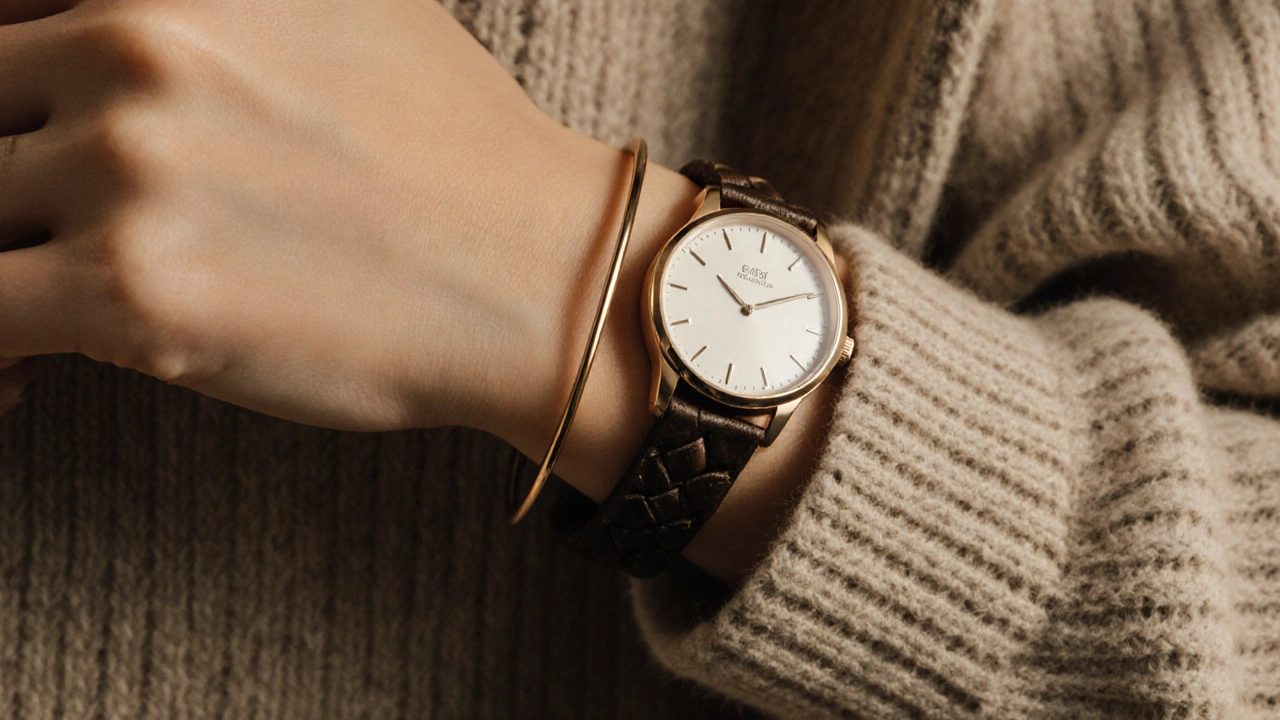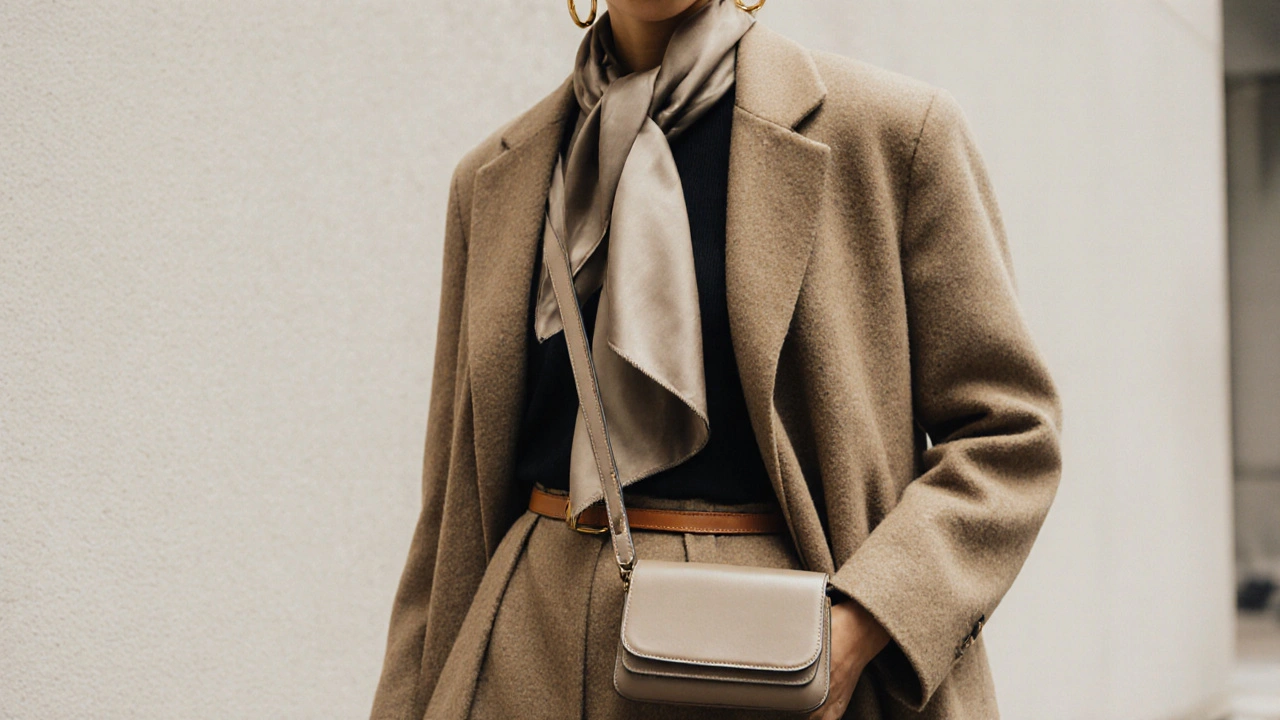Ever put on a necklace, a scarf, a belt, and a crossbody bag-only to look in the mirror and feel like you’re dressed for a costume party? You’re not alone. Accessory layering isn’t about throwing everything you own at your outfit. It’s about intention. The right combination of jewelry, scarves, bags, and belts can elevate a simple outfit from basic to bold-without looking messy. The trick? Balance. Proportion. And knowing when to stop.
Start with the Foundation: What’s Your Outfit Doing?
Before you reach for your jewelry box, look at your clothes. Are you wearing a chunky knit sweater? A sleek turtleneck? A flowy dress with a high neckline? Your clothing sets the tone. A high collar already takes up visual space, so skip a long pendant necklace. Instead, go for stud earrings or a delicate choker. A loose, open coat? That’s your cue to add a statement scarf. The outfit is the canvas. Accessories are the brushstrokes. Don’t paint over the whole thing.Jewelry: Less Is More, Unless You Know How to Stack
Stacking necklaces sounds trendy, but it’s easy to turn into a tangled mess. The secret? Vary lengths and textures. Pick one focal piece-a medium-length pendant or a bold hoop-and build around it. Add a shorter choker (14-16 inches) and a longer chain (24-30 inches). Keep the metals consistent. Mixing gold and silver is fine, but do it on purpose. Don’t throw on three gold chains, two silver rings, and a bronze bracelet and hope for the best.For bracelets, layer thin bangles with one wider cuff. If you’re wearing a watch, make sure it’s part of the stack-not an afterthought. A leather strap watch pairs well with woven bracelets. A metal band works with metal rings. And never wear more than three pieces on one wrist. Anything more looks like you raided a thrift store.
Scarves: Shape, Weight, and Drape Matter
Not all scarves are created equal. A lightweight silk scarf drapes differently than a wool infinity loop. A silk scarf tied loosely around your neck adds polish to a plain shirt. A chunky knit infinity scarf? That’s a statement on its own. Don’t layer it with a necklace-it’ll compete. Instead, let the scarf be the hero.Try this: Fold a square scarf into a triangle, drape it over your shoulders like a shawl, and pin it at the front with a brooch. Now you’ve turned a scarf into a cape. It works with a blazer, a coat, even a simple tee. If you’re wearing a belt, make sure the scarf doesn’t get caught under it. That’s a quick way to ruin the flow.
Belts: Structure, Not Just Decoration
Belts aren’t just for holding up pants. They’re a tool to define your shape. Wear one over a long coat to break up the silhouette. Cinch a loose dress at the waist to add structure. A wide belt (2-3 inches) makes a strong statement. A thin belt (under an inch) feels delicate-perfect under a cardigan or over a trench.Here’s the rule: If you’re wearing a belt, don’t wear a bulky bag with a thick strap that sits at the same height. Your waist becomes a visual clutter zone. A crossbody bag works best when the strap falls below the belt line. A structured handbag? Let it hang free. Don’t tuck it under the belt. That’s a fashion faux pas.

Bags: Size, Shape, and Position Are Everything
A small clutch with a long chain? That’s a statement. A large tote with a short strap? That’s practical. But when you layer accessories, the bag’s position matters more than its style. If you’re wearing a belt at your natural waist, your bag should sit below it. If you’re wearing a long coat, let the bag hang freely-don’t tuck it in.Color coordination helps. If your belt is brown leather, match your bag’s hardware. If your scarf has a pop of red, pick a bag with red stitching. It doesn’t have to match perfectly, but there should be a thread-literally-connecting them. And avoid carrying two bags at once unless one is a tiny pouch clipped to your belt loop. Two full-sized bags? That’s not layering. That’s moving.
The Golden Rule: One Hero, Two Supporting Roles
This is the easiest way to avoid chaos. Pick one accessory to be the hero. It’s the piece that draws the eye. The rest support it. Maybe your hero is a chunky gold necklace. Then your scarf should be neutral-black, beige, gray. Your belt? Thin, simple leather. Your bag? A solid color, no hardware drama.Or your hero is a bold, oversized tote. Then keep your jewelry minimal-just studs. Skip the belt unless it’s ultra-slim. Let the scarf be a soft, flowing piece that doesn’t compete. The hero doesn’t need backup. It needs space.
Color and Texture: The Silent Partners
Texture is your secret weapon. A chunky knit scarf paired with smooth leather gloves and a patent leather belt? That contrast feels intentional. A velvet clutch with metallic earrings and a braided leather belt? That’s texture harmony.Color-wise, stick to a palette. If your outfit is neutral-black, white, gray, camel-go bold with accessories. A bright red scarf, turquoise earrings, a mustard belt. If your outfit is already patterned-stripes, florals, plaids-keep accessories in one muted tone. Black, navy, or bronze work best. Don’t add another print. That’s visual overload.

Common Mistakes (And How to Fix Them)
- Mistake: Wearing a long necklace with a high neckline. Fix: Swap it for earrings or a brooch.
- Mistake: Belt over a bulky coat with a bag that hits the same spot. Fix: Skip the belt, or wear the bag lower.
- Mistake: Three bracelets, two rings, and a watch on one wrist. Fix: One statement piece, two delicate ones. Max.
- Mistake: A patterned scarf with a patterned bag. Fix: Solid bag. Solid scarf. One pattern only.
- Mistake: Mixing metals randomly. Fix: Pick one dominant metal. Use the other as an accent, not a equal.
Real-Life Examples: What Works in the City
Walk down any street in Manhattan on a weekday morning, and you’ll see this combo: a tailored wool coat, a thin leather belt at the waist, a silk scarf tucked just under the collar, a small structured bag slung across the body, and simple gold hoops. No other jewelry. No extra belts. No clashing textures. It looks effortless because every piece has a role.Another winner: a slip dress, a wide leather belt, a long layered necklace (two chains, one pendant), and a mini crossbody with a chain strap. The belt defines the waist. The necklace draws attention upward. The bag keeps it grounded. It’s balanced. It’s modern. It’s intentional.
When to Stop
You know you’ve gone too far when you feel like you’re wearing your closet instead of your outfit. If you catch yourself adjusting three things at once-pulling up your scarf, shifting your bag, tugging at your necklace-you’ve added too much. Accessory layering should make you feel put-together, not weighed down.Try this test: Take a photo of yourself in natural light. Look at it without thinking. Does one piece stand out? Or does everything fight for attention? If it’s the latter, remove one thing. Then another. Keep going until it feels easy. That’s your sweet spot.
Good layering doesn’t shout. It whispers. And when it does, people lean in to listen.
Can I wear a belt and a scarf together?
Yes, but only if they don’t compete. Wear a belt at your waist and a scarf around your neck. Avoid thick scarves that get tucked under the belt-that creates bulk and mess. A lightweight silk scarf works best. Let the scarf flow freely, and keep the belt clean and defined.
How many pieces of jewelry should I wear at once?
Three is the max on one area-like your neck or wrist. One statement piece, two supporting ones. On your neck: a choker, a pendant, and a long chain. On your wrist: one bracelet, one ring, one watch. More than that starts to look cluttered, not curated.
Should my bag match my belt?
Not exactly, but they should feel connected. Match the metal tone-gold hardware with gold belt buckle. Or match the material-leather bag with leather belt. Color doesn’t need to be identical, but it should live in the same family. A camel belt with a brown bag? Perfect. A red belt with a green bag? That’s a stretch unless it’s intentional.
Is it okay to layer scarves?
Only if they’re different weights and lengths. A thin silk scarf under a chunky knit works. Two thick scarves? No. You’ll look like you’re wearing a blanket. The goal is dimension, not bulk. Keep the top layer lighter and more fluid.
What if I love lots of accessories but always look messy?
You’re not messy-you’re just not editing. Try the one-hero rule: pick one standout piece, then make everything else quiet. A bold necklace? Skip the earrings. A patterned scarf? Wear solid jewelry. You don’t need to wear everything you own. You need to wear what makes sense together. Less is always more powerful.


Write a comment